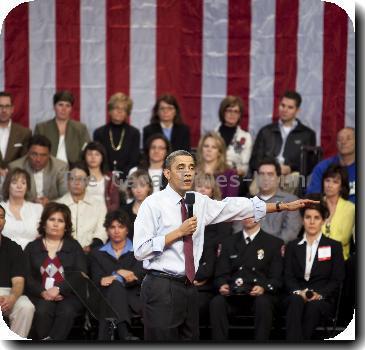At NYC stop, Sandra Day O’Connor says more justices might skip future State of Union addresses
By Larry Neumeister, APTuesday, April 6, 2010
O’Connor: More justices may skip State of Union
NEW YORK — The first woman to sit on the nation’s highest court said Tuesday she wouldn’t be surprised if fewer justices attend State of the Union addresses after President Obama criticized a recent ruling at this year’s address.
Retired Supreme Court Justice Sandra Day O’Connor told several reporters at New York Law School that it was never easy to get justices to attend.
“It is not much fun to go because you put on a black robe and march in and you’re seated in the front row, (you) put your hands in your lap and have no expression on your face throughout the proceedings. You can clap when the president comes in and when he leaves and that’s it. It’s very awkward,” she said.
O’Connor, 80, who retired in 2006 after serving 25 years on the Supreme Court, spent several hours at the law school, where she delivered a lecture urging better education about civics for young people.
During discussions with students and journalists, she also recommended more diversity on the court, saying more women, non-judges and a Protestant would help.
“I think that religion should not be the basis for an appointment, but if that were the case, one would expect somewhere in the nine to see a Protestant or two,” she said. “You’ll probably see someone eventually.”
O’Connor said the controversy will fade over Obama’s criticism of the court’s recent campaign finance decision during his annual address to Congress. His remarks prompted Justice Samuel Alito to shake his head and mouth the words “not true.”
But she said she wouldn’t be surprised if fewer justices attend in the future. Justices John Paul Stevens and Antonin Scalia haven’t gone for years and Justice Clarence Thomas rarely goes.
“You might see a diminution in numbers. It’s always been uncomfortable. There were always people who thought, ‘God, do we have to go? Let’s don’t.’ So it’s been kind of a struggle to get them there anyway,” O’Connor said.
In blunt language that sometimes drew chuckles from the crowd, O’Connor addressed a variety of issues during a question-and-answer period after she delivered the school’s Sidney Shainwald Public Interest Lecture.
Asked if it’s a good idea to have a diverse Supreme Court, she said: “Boy is it ever. … I’m a judge. I like judges. But we don’t need them all on the court. And we need people of different backgrounds.”
She noted that Canada has four women on its high court, including a female chief justice.
“Now what’s the matter with us? You know, we can do better,” O’Connor said.
O’Connor said she does not think the Supreme Court should try to increase its caseload and said the number of cases under consideration might be shrinking because the lower courts were more often getting it right.
“You oughta be grateful. The court can really mess it up,” she said.
She said she has been frustrated in her project to promote a free interactive Web program on the U.S. court system for middle schoolers nationwide. The program, called Our Courts, lets students participate in realistic government simulations.
“You talk about a bureaucratic mess,” she said of the state school systems. “There’s nobody really in charge of everything. It’s the darndest thing you’ve ever seen. Each state is a bureaucratic nightmare.”
She said she has adjusted to her new life, which includes promoting the Web program, and does not regret leaving the court when her husband was ill and needed her.
“I’m not sitting around saying, ‘Oh, my gosh. I miss it,’” she said. “And I think it’s better if justices know when it’s time to step down.”
One woman asked her if she thought women process things and think differently as judges.
“No, I don’t. I think at the end of the day, a wise old woman and a wise old man are going to come to the same conclusion,” she said.
Tags: Barack Obama, Events, Executive Branch, New York, North America, State Of The Union Address, United States

